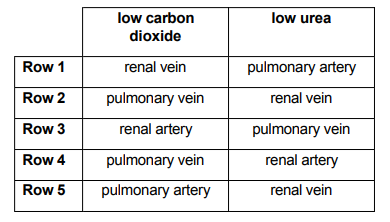Which row of the table correctly identifies a blood vessel that has a low concentration of carbon dioxide and a vessel that has a low concentration of urea?

A. Row 5
B. Row 2
C. Row 4
D. Row 3
E. Row 1
1 Like
The answer to this question is B or row #2. To understand the rationale behind this answer, you must be aware of 2 concepts that are involved in this question, which are the anatomy involved and substances mentioned.
The anatomy involved in this question:
- The pulmonary vein(s): These are the vessels that carry blood that has already passed through the lungs (in other words, oxygenated blood), back to the left atrium before it is pumped into the circulation for the various tissues and organs.
- The renal vein: This vessel carries the blood that has already passed through the filtration system of the kidneys, thus being oxygenated and mostly free from wastes that have already been excreted through the urine, back to the inferior vena cava.
The substances involved in this question:
- Carbon dioxide: This is the by-product of cellular respiration after oxygen has been used up by the cell to perform its necessary functions. The aim of the body is to eliminate CO2, through the pulmonary system, where passing blood is oxygenated, and CO2 is effectively released as we breathe out.
- Urea: This is a nitrogen-containing substance that is formed by the liver from excess nitrogenous compounds that are found in the body. The job of the kidney is to filter out this urea from the blood it receives from the renal artery, and to excrete it into the urine.
Let’s now put those 2 concepts together to answer this question:
- If you notice the headers of the columns of the table given, it says “low carbon dioxide” and “low urea”. What does this imply? The question is asking you to discern, which of the anatomical structures listed contains blood that has low amounts of these waste products. Thus, you have to think of which structures contain blood that has already passed through the system that is tasked to remove the substances from the body in the first place. It now makes sense why row 2 is the correct answer. The pulmonary vein contains low carbon dioxide because the blood it carries has just been oxygenated by the lungs, at the same time, the carbon dioxide has been eliminated through the respiratory system. The renal vein contains low urea since the blood it carries has already passed through the filtration function of the kidney, where it is safe to assume that the urea brought by the renal artery has already been excreted in the urine.
7 Likes

